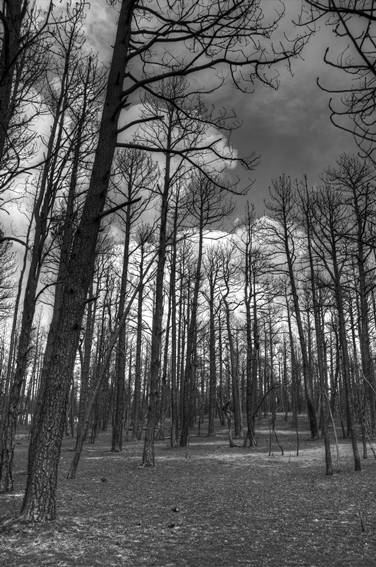
Today the Black Forest Fire District Board released a report on how the Black Forest Fire was managed on the first day. Starting on the northeast side of Colorado Springs, the fire killed two people, destroyed 486 homes, and damaged 37 others in June of 2013.
The local county Sheriff, Terry Maketa, has been extremely critical of Fire Chief Bob Harvey,who was responsible for the initial attack. Sheriff Maketa has given several blistering interviews to the media criticizing Chief Harvey’s actions that day. His main point was that he thinks the Chief should have turned over the fire to him or the county much earlier.
The documents released today, a statement from the Board and a summary of the report, show strong support for Chief Harvey and generally appear to disprove some of the charges leveled by Sheriff Maketa.
One of the Sheriff’s main contentions was that the Chief waited many hours before turning over the management of the fire to the County or the Sheriff, which the Sheriff said occurred at 8:23 p.m..
The report concluded that the fire was reported at 1:42 p.m. on June 11. The first engine arrived about six minutes later. At 2:14 p.m. a strong wind of 25 to 35 mph developed, increasing the rate of spread and pushing the fire into the crowns of the trees. Firefighters were then forced into defensive positions for their own safety. Between 3:45 and 3:55 p.m. Chief Harvey verbally turned over command of the fire to County Deputy Fire Marshall Scott Campbell, a Type 3 Incident Commander. At 4:08 p.m. Mr. Campbell signed a document confirming the transfer of command. Other signatures on a Delegation of Authority document were obtained over the next several hours, with the last occurring at 8:23 p.m.
The Board commissioned retired Greenwood Village Police commander Dave Fisher to direct the inquiry. Mr. Fisher retired in October after a 29-year career at the suburban Denver department. He was assisted by Dave Daley, an operations executive officer at South Metro Fire Rescue in Centennial.
The statement of the Board criticized the attacks by the Sheriff and the media:
…This misadventure started because one elected official saw fit, for whatever personal or political reason, to make unsubstantiated allegations about our Chief’s performance following the onset of the Black Forest fire. We say unsubstantiated because the investigation has proven the facts, and what’s been established is very, very far from what was alleged. We have no way of knowing the motive in making these allegations and we are certain we will never know.
We also must acknowledge how disappointed we are in the conduct of some Colorado Springs media outlets in simply running with the allegations, and broadcasting the untruths, without a speck of legitimate journalistic enterprise to establish their validity. The media accepted the allegations at face value, further damaging this department’s reputation, and continued to repeat the damaging suppositions – again, leading us to hire our own investigator to get at the heart of the matter.
Colorado is one of a few states that have the policy of assigning the suppression of wildfires in unincorporated areas to the county employee with law enforcement responsibilities in those areas — the County Sheriff — rather than a person with expertise in fire suppression.

A Fire Behavior Analyst could have easily predicted the shape and size of this incident given the fuel, wind and weather conditions. The tactics for a fire like this are to anchor and flank while keeping one “foot” in the black. Fuels management or mitigation could have been the major contribution to control, regardless of who is in charge.
JP you’re right. This whole “flap” is just another symptom of an inadequate system that keeps good people from working as a team.
I have to agree with Justin. The weather conditions that day were set for the perfect storm. No matter what type of IMT you had in place, given the resources and the weather conditions would have made a difference that day. It’s unfortunate that politics is rearing it’s ugly head in this. Instead of finger pointing and running each other down in the media, now would be the time to use this as a learning experience. Unfortunately it’s hard to sit down in the same room and have a constructive dialogue between agencies after one leader has slammed another in the media. Unfortunately it’s up to those of us out on the street who have to pay the price.
Why does everyone get caught up in this? Do we think the county could have put this fire out if it had been turned over to them 10 min, 1 hr, 3 hrs earlier? The results would have been the same through the initial wind push regardless of who was “in charge”.
Colorado’s biggest issue is Colorado. They can’t get out of their own way. Archaic jurisdiction of wildfires. A newly created state agency that is trying to recreate the wheel instead of mirroring very successful state agencies already in existence. The USFS shows little leadership in taking the Region to the 21st century with just downright ridiculous IA and aerial resource management. I hope to live long enough to see Colorado meet the wildfire challenge head on. Jurisdictional lines in the sand and infighting will unfortunately keep Colorado in the Stone Age of firefighting for years to come. So sad and so very frustrating.